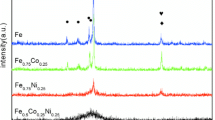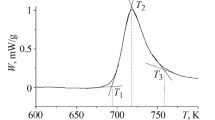We determine the kinetic parameters of crystallization of amorphous metallic alloys based on aluminum doped with rare-earth metals (REM) by the method of differential scanning calorimetry. It is shown that the amorphous metallic alloys based on aluminum crystallize in three stages. By using the Kissinger, Avrami, and Ozawa models, we compute the energies of activation for the first stage of crystallization on the basis of the results of differential scanning calorimetry. It is shown that the Al–REM–Ni alloys are nanocrystallized by a kinetically controlled mechanism. The substitution of Gd for Y leads to a decrease in the temperature of nanocrystallization by 20–40°K. At the same time, the substitution of Dy for Y leads to an increase both in the temperature of nucleation and in the temperature of growth of nanocrystals. As a result of the addition of Fe to the composition of the alloy, the range of nanocrystallization shifts by about 100°K. According to the Matusite model, for constant temperatures of phase transitions, it is shown that the growth of nanocrystals in amorphous metallic alloys of the Al–REM–Ni system is realized in the 1D direction and linearly (interface control). In amorphous alloys, Dy substantially increases the temperatures of phase transitions and the number of atoms in clusters and decreases the microhardness.



Similar content being viewed by others
References
R. Hasegawa, “Applications of amorphous magnetic alloys,” Mater. Sci. Eng. A,375–377, 90–97 (2004).
J. Kovac, J. Bednarcik, P. Kollar, M. Konc, and K. Polanski, “The magnetic properties and structure of Co70.3Fe4.7Si10B15 powder prepared by ball milling,” Phys. Status Solidi A,196, No. 1, 209–212 (2003).
B. Idzikowski, P. Svec, and M. Miglierini (editors), Properties and Applications of Nanocrystalline Alloys from Amorphous Precursors, Chapter 7: E. Illeková, “Kinetic characterization of nanocrystal formation in metallic glasses,” in: NATO Science Series II, Vol. 184, Springer, Dordrecht (2003), pp. 79–89.
S. Mudry, Yu. Kulyk, and S. Zhovneruk, “Nanocrystallization in Fe75Mo2.5Mn2.5Si6B14 amorphous alloy,” J. Alloys Comp.,586, 126–129 (2014).
V. Pokatilov and N. Djakonova, “Experimental evidences of clusters with different short range order in amorphous alloys,” Hyperfine Interact.,59, 525–528 (1990).
Yu. M. Poplavko, O. V. Borysov, and Yu. I. Yakymenko, Nanophysics, Nanomaterials, and Nanoelectronics: A Tutorial [in Ukrainian], “Kyiv Polytechnic University” Ukrainian National Technical University, Kyiv (2012), pp. 16–17.
F. F. Marzo, A. R. Pierna, and M. M. Vega, “Effect of irreversible structural relaxation on the electrochemical behavior of Fe78–x Si13B9 Cr(x=3,4,7) amorphous alloys,” J. Alloys Comp.,329, 108–114 (2003).
T. Mika, M. Karolus, L. Boichyshyn, G. Haneczok, B. Kotur, and V. Nosenko, “Crystallization of Al87Y5Ni8 amorphous alloys doped with Dy and Fe,” Chem. Met. Alloys,5, 50–58 (2012).
L. Heireche and M. Belhadji, “The methods of Matusita, Kissinger and Ozava in the study of the crystallization of glasses in the case of Ge–Sb–Te alloys,” Chalcogenide Lett.,4, No. 2, 23–33 (2007).
J. A. Augis and J. E. Bennett, “Calculation of the Avrami parameters for heterogeneous solid state reactions using a modification of the Kissinger method,” J. Therm. Anal.,13, 283–292 (1978).
T. H. Pereverzeva, Modification of the Surface of Amorphous Metallic Alloys Based on Iron [in Ukrainian], Author’s Abstract of the Candidate-Degree Thesis (Chemical Sciences), Lviv (2015).
V. K. Nosenko, E. А. Segida, А. А. Nazarenko, Т. N. Moiseeva, S. А. Kostyrya, Е. А. Svirdova, and V. I. Tkach, “Influence of the substitution of cobalt for nickel on the thermal stability and microhardness of Al86Ni8Gd6 and Al86Ni8Y6 alloys with amorphous and nanocomposite structures,” Metallofiz. Noveish. Tekhnol.,37, No. 1, 49–65 (2015).
Author information
Authors and Affiliations
Corresponding author
Additional information
Translated from Fizyko-Khimichna Mekhanika Materialiv, Vol. 55, No. 1, pp. 21–29, January–February, 2019.
Rights and permissions
About this article
Cite this article
Boichyshyn, L.М., Khrushchyk, K.І., Kovbuz, М.О. et al. Specific Features of the Transition of Amorphous Al87REM5Ni8(Fe) Alloys Into the Crystalline State Under the Influence of Temperature. Mater Sci 55, 17–26 (2019). https://doi.org/10.1007/s11003-019-00246-7
Received:
Published:
Issue Date:
DOI: https://doi.org/10.1007/s11003-019-00246-7




